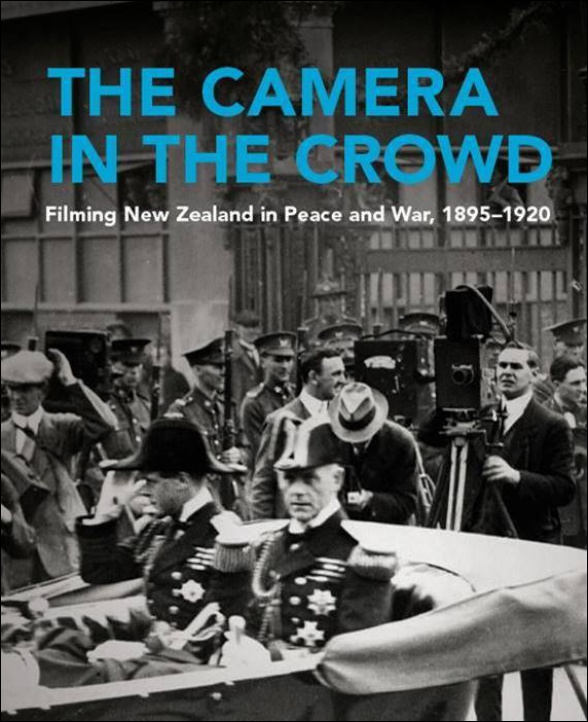The Auckland commercial traveller AH Whitehouse was the first to
show films by Edison's peepshow Kinetoscope and to direct
the filming of scenes at the the opening of the Auckland
Industrial and Mining Exhibition in December 1898. The pair
made nine other films, but their output was soon overtaken
by the Salvation Army, which became the largest film
producer in Australasia by the turn of the century. New
Zealand quickly developed a small corps of professional
cameramen to feed the country's insatiable appetite for
movies. Pugsley has documented the history of those
pioneering cinematographers and theatre owners such as Henry
Hayward and John Fuller who screened their films. He has
painstakingly researched not only domestic film production,
but also the Kiwi 'Diggers' of WWI. As he explains in his
Introduction: "Film is made to be seen on screen and this
book reflects this by providing stills from the films
discussed. Titles of surviving films are also identified by
a small projector in the margin that allows you to access
the film online and have a look at what you are reading
about ... Each page also includes a still from the 1914 film
Auckland's Expeditionary Force ... You can enjoy
watching the volunteers march past by flipping through the
pages in the manner of the once very popular flip
books." Pugsley is one of New Zealand's leading military
historians who has also nurtured a long-standing passion for
film. Told in his characteristically straightforward and
engaging style, he combines these twin interests in The
Camera in the Crowd, which brilliantly brings to life
the first years of film-making in New Zealand through war
and
peace.
The possibilities of film as a documentary record immediately captured the Kiwi imagination when the first reels of silver nitrate stock reached New Zealand in 1895. The Camera in the Crowd brings to life twenty-five exhilarating years of film making and picture screening in a sumptuously illustrated hardback published by Oratia that tells the story through surviving footage unearthed from the national film archives.
ENDS
Art & Entertainment | Book Reviews | Education | Entertainment Video | Health | Lifestyle | Sport | Sport Video | Search
Advertisement - scroll to continue reading
LATEST HEADLINES
- CULTURE
- HEALTH
- EDUCATION
- New Zealand Radio Show Heard On A Local Radio Station In California, USA 8:26 PM | The New ...
- Rhythm And Vines Clean-up Of Waiohika Estate And Nearby Areas Could Take Two Wee... 8:10 PM
- Tennis: Osaka Outlasts Baptiste, Makes It Through To ASB Classic Semi-finals 7:59 PM | RNZ
- ‘Ultraviolence’ - Pere Ibañez Transition From Photography To Music 5:53 PM | Pere Ibanez
- Lawson And Grantham Qualify To Keep Bowls Three-Peat Hopes Alive 03/01/25 | Bowls New Zealan...
- Tattoo Artists Find Inspiration In Chinese Culture 03/01/25 | RNZ
- Cricket: Top Run Scorer Keeps His Eye On The Ball 03/01/25 | RNZ



 Bowls New Zealand: Lawson And Grantham Qualify To Keep Bowls Three-Peat Hopes Alive
Bowls New Zealand: Lawson And Grantham Qualify To Keep Bowls Three-Peat Hopes Alive Te Whatu Ora Health NZ: Health Warning – Unsafe Recreational Water Quality At South Bay And Peketā Beaches And Kahutara River Upstream Of SH1
Te Whatu Ora Health NZ: Health Warning – Unsafe Recreational Water Quality At South Bay And Peketā Beaches And Kahutara River Upstream Of SH1 Wikimedia Aotearoa NZ: Wikipedian At Large Sets Sights On Banks Peninsula
Wikimedia Aotearoa NZ: Wikipedian At Large Sets Sights On Banks Peninsula Water Safety New Zealand: Don’t Drink And Dive
Water Safety New Zealand: Don’t Drink And Dive NZ Olympic Committee: Lydia Ko Awarded Lonsdale Cup For 2024
NZ Olympic Committee: Lydia Ko Awarded Lonsdale Cup For 2024 BNZ Breakers: BNZ Breakers Beaten By Tasmania Jackjumpers On Christmas Night
BNZ Breakers: BNZ Breakers Beaten By Tasmania Jackjumpers On Christmas Night